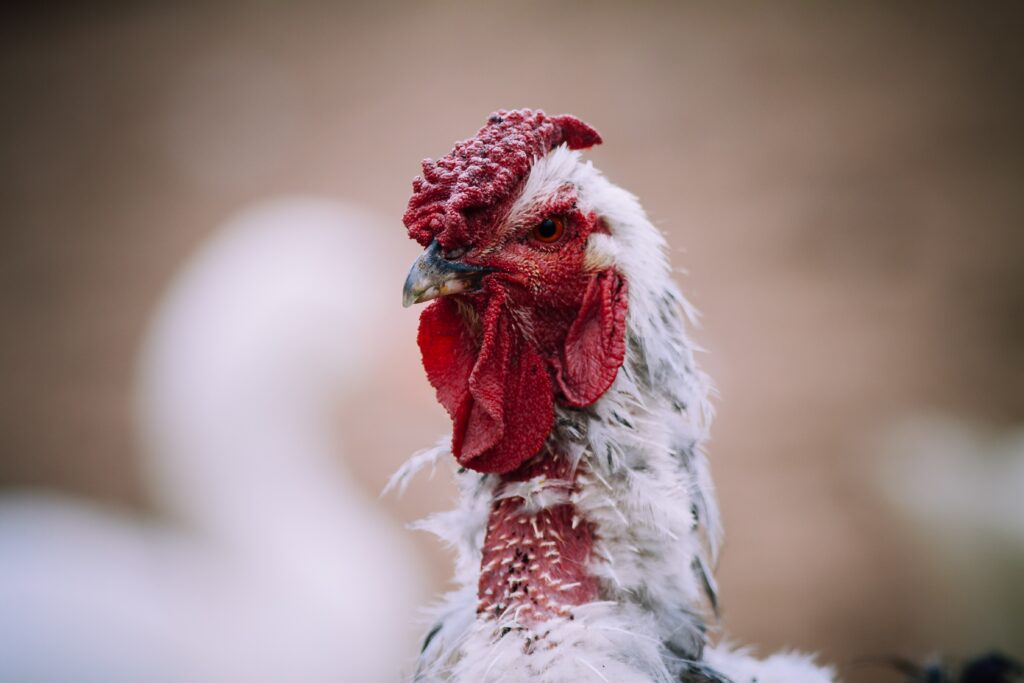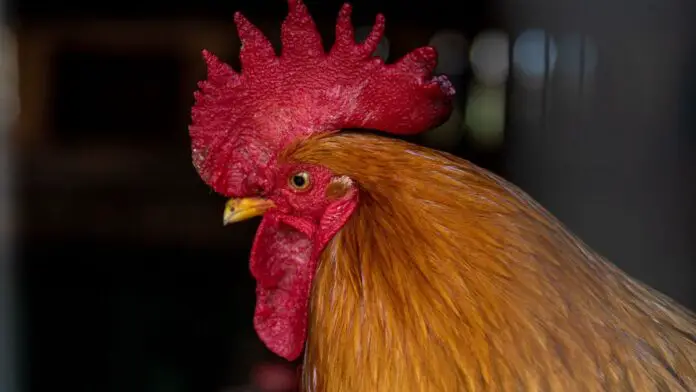Some links on this page may contain affiliate links which means that, if you choose to make a purchase using the link, Agricfy.com may earn a small commission at no extra cost to you. For more information, go to our Affiliate Disclosure Page!
Introduction
The chicken comb is a fleshy growth on the top of a chicken’s head. It regulates the chicken’s body temperature and comprises connective tissue and blood vessels. The comb can also be used to differentiate between male and female chickens.
While the chicken comb may seem like a small and insignificant part of the chicken, it actually plays an important role in its overall health. With so many different types, it can sometimes be challenging to determine which comb your chickens have.
Even though it might seem scary, everyone can tell a chicken comb difference. This article will discuss what you need to know about chicken combs, from their function to appearance.
What Is a Chicken Comb?

The chicken comb is a fleshy growth on the top of a chicken’s head. It regulates the chicken’s body temperature and is a secondary sex characteristic. The comb can come in different shapes and sizes and is usually red in color.
While a chicken comb is not necessary for a chicken’s survival, it does serve an important purpose. In hot weather, the comb helps to cool the chicken’s blood as it circulates through the comb’s vessels. This regulatory function is vital for chickens, as they cannot sweat and cool their bodies as humans do.
While chicken comb can be eaten, it is sometimes used in folk medicine. Some believe that chicken comb can help to treat various ailments, such as headaches, fevers, and arthritis.
However, these statements are not backed by any scientific evidence.
Types of Chicken Comb
A variety of chicken combs can be found on different breeds of chickens. They include:
1. Buttercup
The buttercup comb has the appearance of being made up of two single combs. It’s interesting to note that only one breed in the world—the Sicilian Buttercup—has this comb. This sort of comb is ideal for chickens that reside in hot climates since it promotes speedy cooling.
2. Carnation
Another distinctive comb shape is the carnation comb. This comb is unique to the Empordanesa and Penedesenca breeds. It resembles a single comb in shape, but due to the additional spikes, it appears more like a crown.
3. Cushion Comb
The cushion comb rests low on the head and is quite tiny. This comb is exceptionally smooth, in contrast to other combs that are rough and lumpy. It appears to be a tiny cushion perched atop the chicken’s head.
The Chantecler is one of the most well-known chickens with a cushion comb. The cushion comb is ideal for chickens in colder climates because it is thin and compact, which helps prevent frostbite and maintain body heat.
The cushion comb is used to help the chicken protect its head and face from predators.
4. Pea Combs
Pea combs are really tiny. The middle ridge is slightly taller than the other two, and they have three ridges. Tiny bumps add texture to each of the ridges.
Brahmas and Ameraucanas are two of the most popular chicken breeds with pea combs. The pea comb is ideal for chickens in colder areas since it is tiny and less likely to become frostbitten.
A Pea comb is used to help protect the chicken’s head from cold weather.
5. Rose Combs
Rose combs hug the skull and are incredibly flat. This comb contains numerous tiny bumps and a spike-like finish. The Wyandotte and Dominique are two breeds with rose combs.
Again, due to its modest size, this comb makes chickens with it well-suited to cold areas and less prone to suffer from frostbite.
6. Single Comb
The most popular style of chicken comb is a single comb. This is the chicken comb that most people picture when they think of one.
It has a mountain-like shape and five or six serrations (points) on the comb. The serrations are often more noticeable in the middle of the comb and smaller at the front and back. Despite being recognized as upright, this comb can occasionally be uneven and floppy in hens.
This comb type is shared by Leghorns and Ayam Cemani, but the latter has a black comb.
7. V-shaped comb
The V comb often called the Devil’s Horn, is unique to certain kinds of chickens. The Sultan, Crèvecoeur, and La Flèche are examples of breeds.
8. Strawberry comb
This chicken comb is positioned at a forward angle on your chicken’s head. It appears on Malay and Yokohama hens and resembles a strawberry.
9. Walnut Comb
This comb is fashioned like a sizable walnut and protrudes forward from your chicken’s head. This comb belongs to Silkie and Orloff.
Chicken Comb Diseases and Treatment
No matter how healthy your flock is, there’s always a chance that something could go wrong. That’s why it’s important to be familiar with the various chicken diseases that your chickens can get. We’ll look at six common chicken comb diseases and what you can do to treat them.
1. Fowl Pox
The wattles, comb, ears, and eyes will all develop nodules, eventually converting into scabs from the dry form of chicken pox. The mouth and respiratory system are affected by wet pox, which makes it difficult to breathe and eat. It takes three to five weeks for the fowl pox to clear up. The prognosis for recovery is generally reasonable. Both poxes (dry and wet) have side effects, including growth retardation and reduced egg laying.
Treatment
- Fowl pox has no treatment. However, a commercially available fowl pox vaccine is given to chickens using the wing web method to control and prevent the disease. All chickens should receive this between the ages of 12 and 16 weeks.
2. Avian Pox
Avian pox is a viral disease that affects chickens of all ages. Symptoms include lethargy, loss of appetite, and swollen combs.
Treatment
- Isolation of affected birds
- Administration of antiviral drugs.
3. Fowl Cholera
Fowl cholera is a bacterial disease that affects chickens of all ages. Symptoms include lethargy, loss of appetite, ruffled feathers, and swollen combs.
Treatment
- Vaccination
- Administration of antibiotics.
4. Newcastle Disease
Newcastle disease is a viral disease that affects chickens of all ages. Symptoms include lethargy, loss of appetite, ruffled feathers, and swollen combs.
Treatment
- Vaccination
- Isolation of affected birds.
5. Infectious Bursal Disease
The infectious bursal disease is a viral disease that affects young chickens. Symptoms include lethargy, loss of appetite, ruffled feathers, and swollen combs.
Treatment
- Vaccination
- Administration of antiviral drugs.
6. Frostbite
Frostbite can be identified by several black dots on your chicken’s comb. When the water in the chicken’s bodily tissues freezes, it results in frostbite. Because blood cannot reach the region, the tissue perishes. The tissue turns white or black once it has expired.
Never remove these darkened spots (even when the chicken is healthy again). The good tissue is protected by the dead tissue.
Treatment
Simply relocating your chickens to a warmer location or providing them with a heat source will prevent frostbite.
How To Keep Chicken’s Comb Healthy
The healthiest comb for your chicken is what you want to maintain. There are various ways to do this, which we have listed below.
- Keep an eye out for Overpacking
Sometimes, a group of chickens would attack one and peck them severely. Your chicken’s health may suffer from this, mainly if they focus on the comb.
Any chicken that appears to be being picked on should be removed. Smaller or underweight chickens might be placed in their own pen. Before reintroducing them to the main flock, give them time to recover and become healthy.
- Antibiotics
Open sores or blisters are prone to infection. Watch out for exposed spaces and take care not to unintentionally pop any blisters. Ask your veterinarian if any antibiotics are suggested. This may be done to avoid infection or hasten the healing process for your chicken. Vaseline can be applied as a coating on large combs in the winter to prevent frostbite.
Do Chickens Lose Their Combs Over Time?
Typically, no. Countless blood arteries are found throughout the comb. The comb shouldn’t seem unhealthy or shrivel unless your chicken is ill. When they stop laying, your hens’ combs could shrink slightly, but they won’t lose all of it.
Can A Chicken Comb Grow Back?
A chicken comb that is lost or hurts from sickness or damage won’t grow back. Whatever it was that first made your chicken’s comb shrivel or become injured, it can heal.
Conclusion
Despite being an apparently small part of the chicken’s anatomy, the combs are crucial to the animal’s general health. They assist in keeping them healthy by letting you know how they are doing. Start paying close attention to them.
Additionally, take action to maintain their health. In warmer climates, some combs perform better than others, and vice versa.
They are typically a solid indicator that something is amiss with your chicken and a good reminder to look for any potential underlying issues.
If you want to dive deep into knowing about poultry farming, you start your own backyard poultry farm. This will give you an opportunity to put into practice some of the things mentioned in the article above.


